
News
ਦਸੰ. . 18, 2024 04:30 Back to list
Top Quality Sodium Gluconate as an Effective Chelating Agent for Various Applications
High Quality Sodium Gluconate A Versatile Chelating Agent
Sodium gluconate, a sodium salt of gluconic acid, is a high-quality chelating agent widely recognized for its versatile applications in various industries. As a biodegradable and environmentally friendly compound, sodium gluconate has garnered significant attention in recent years as manufacturers and consumers alike become more conscious of the ecological impacts of chemical usage. This article delves into the properties, benefits, and applications of sodium gluconate, highlighting why it is considered a superior chelating agent.
Properties of Sodium Gluconate
Sodium gluconate is a white or yellowish crystalline powder that is soluble in water. Its chemical formula is C6H11NaO7, and it has a molecular weight of approximately 218.17 g/mol. The compound is derived from the fermentation of glucose, making it a sustainable product that is readily available from natural sources. Sodium gluconate is known for its stability and ability to maintain its chelating properties across a variety of pH levels and temperatures.
One of the defining characteristics of sodium gluconate is its excellent ability to form stable complexes with metal ions. This chelation process occurs when sodium gluconate interacts with metal ions to form soluble complexes, which prevent the metals from precipitating and promote better handling of metal-containing solutions. Additionally, its low toxicity profile makes it suitable for various applications, from food processing to agriculture.
Benefits of Using Sodium Gluconate as a Chelating Agent
The use of sodium gluconate as a chelating agent comes with numerous advantages, particularly in its application across different sectors. One of the primary benefits is its strong complexation ability with a wide range of metal ions, including calcium, magnesium, iron, and aluminum. As a result, it is often employed to inhibit mineral scale formation in water treatment processes, detergents, and cosmetic formulations.
Moreover, sodium gluconate's biodegradability makes it an eco-friendly alternative to traditional synthetic chelating agents like EDTA and phosphates. These synthetic agents, while effective, can contribute to environmental concerns such as water pollution and eutrophication. In contrast, sodium gluconate decomposes naturally, leaving no harmful residues behind.
Sodium gluconate also possesses high solubility and stability in various conditions, making it an ideal chelating agent in different formulations. Its effectiveness remains consistent in both acidic and alkaline environments, providing manufacturers with flexibility in product development.
high quality sodium gluconate chelating agent

Applications of Sodium Gluconate
1. Water Treatment In water treatment, sodium gluconate is utilized to sequester metal ions, preventing scale buildup in pipes and boilers. By keeping metal ions in solution, it enhances the overall efficiency of water systems, prolonging the lifespan of equipment and reducing maintenance costs.
2. Food Industry Sodium gluconate is often used as a food additive and preservative due to its ability to stabilize flavor and enhance the overall quality of food products. It is commonly found in marinades, dairy products, and baked goods where it helps maintain product integrity.
3. Agriculture In agriculture, sodium gluconate serves as a chelating agent for micronutrients. It facilitates the absorption of essential minerals like zinc and iron by plants, thereby optimizing nutrient availability and promoting healthy growth.
4. Cosmetics and Personal Care Due to its low toxicity and ability to enhance product stability, sodium gluconate is increasingly being incorporated into cosmetics and personal care products. It acts as a chelating agent to prevent metal ions from causing discoloration and spoilage and to stabilize formulations.
5. Construction Sodium gluconate is also applied in the construction industry as a water-reducing agent in concrete. Its chelating properties help improve the workability of concrete, thereby enhancing its strength and durability.
Conclusion
Sodium gluconate stands out as a high-quality chelating agent with a plethora of applications across various industries. Its effective complexation with metal ions, coupled with its biodegradable nature, positions it as a sustainable alternative to traditional agents. As the global market continues to evolve towards greener chemistry and sustainable practices, sodium gluconate is set to play a pivotal role in shaping environmentally friendly solutions across diverse sectors. Its versatility, safety, and efficacy make it an essential component in the formulation of products that meet the needs of an increasingly discerning consumer base. As awareness of environmental issues grows, the demand for sodium gluconate is likely to rise, further solidifying its position as a leading chelating agent in the market.
-
OEM Chelating Agent Preservative Supplier & Manufacturer High-Quality Customized Solutions
NewsJul.08,2025
-
OEM Potassium Chelating Agent Manufacturer - Custom Potassium Oxalate & Citrate Solutions
NewsJul.08,2025
-
OEM Pentasodium DTPA Chelating Agent Supplier & Manufacturer High Purity & Cost-Effective Solutions
NewsJul.08,2025
-
High-Efficiency Chelated Trace Elements Fertilizer Bulk Supplier & Manufacturer Quotes
NewsJul.07,2025
-
High Quality K Formation for a Chelating Agent – Reliable Manufacturer & Supplier
NewsJul.07,2025
-
Best Chelated Iron Supplement for Plants Reliable Chelated Iron Fertilizer Supplier & Price
NewsJul.06,2025
